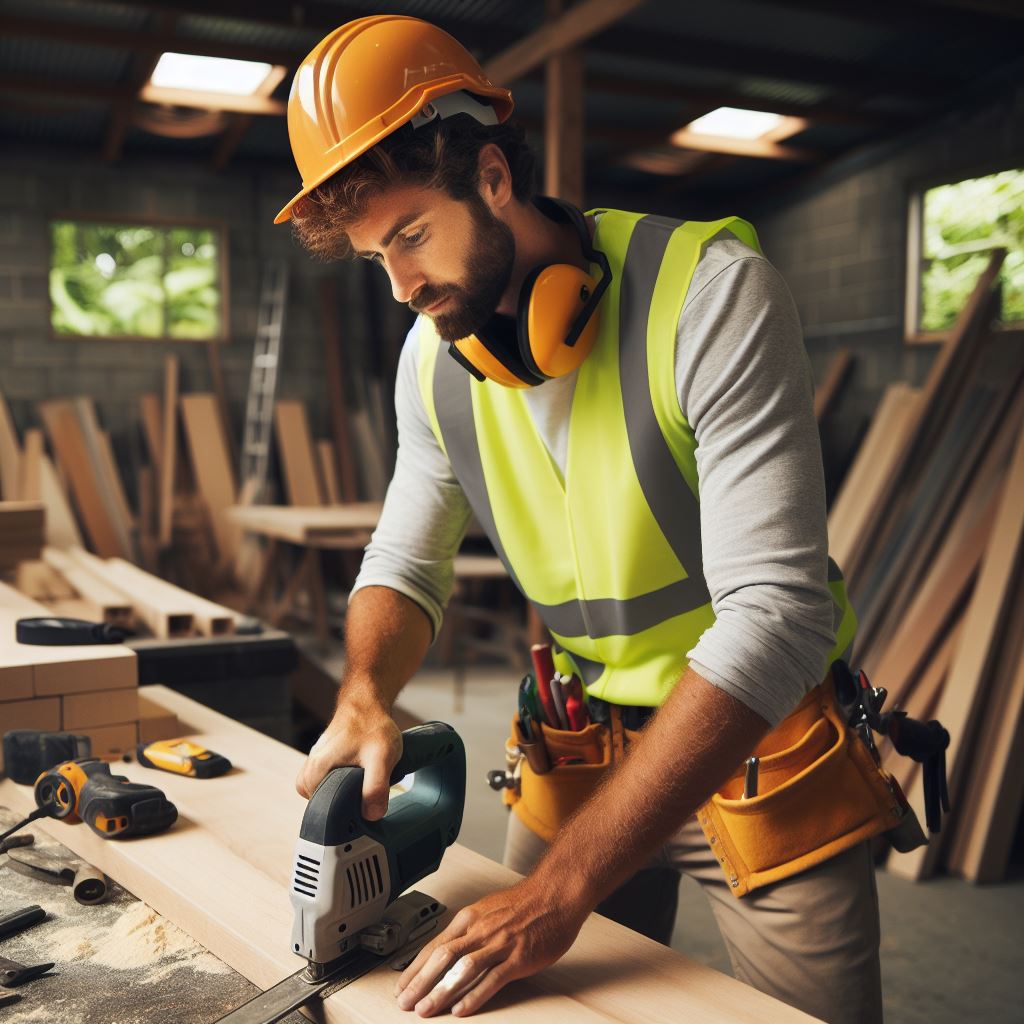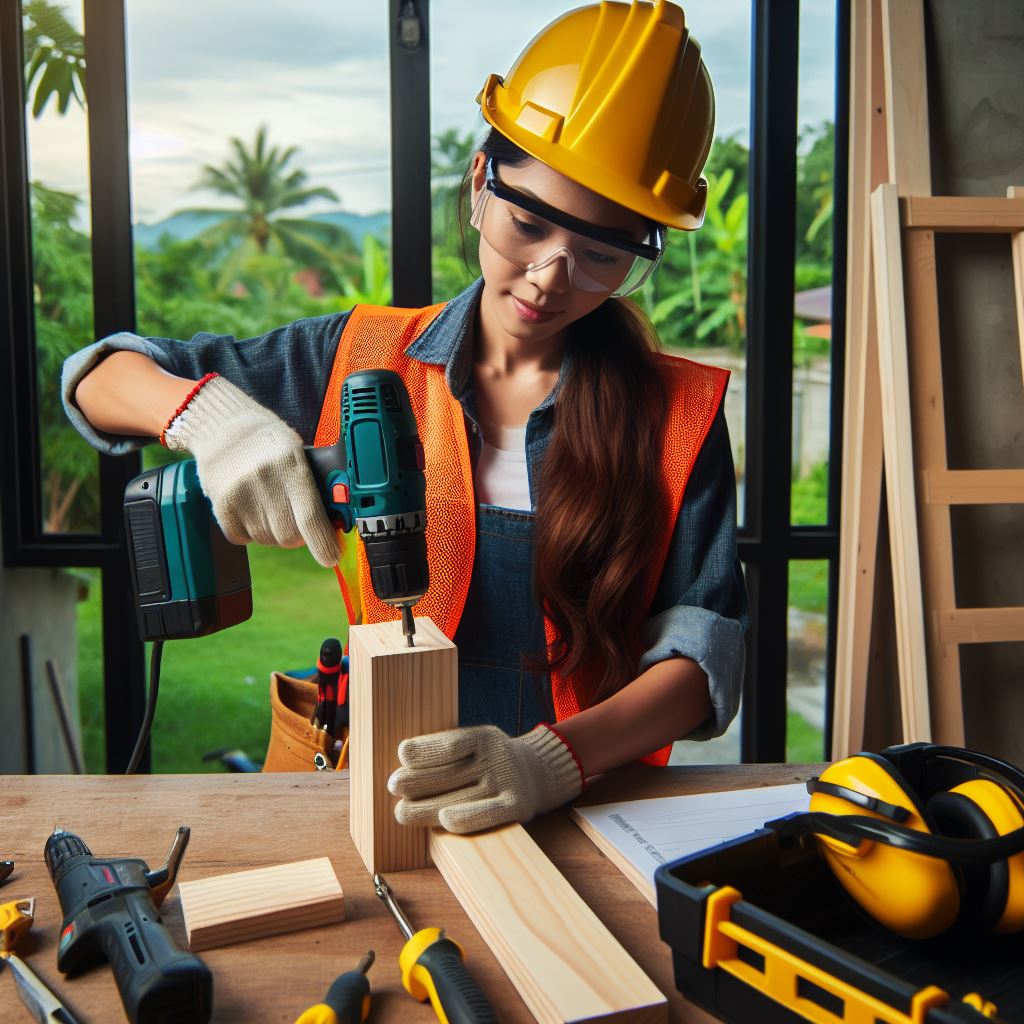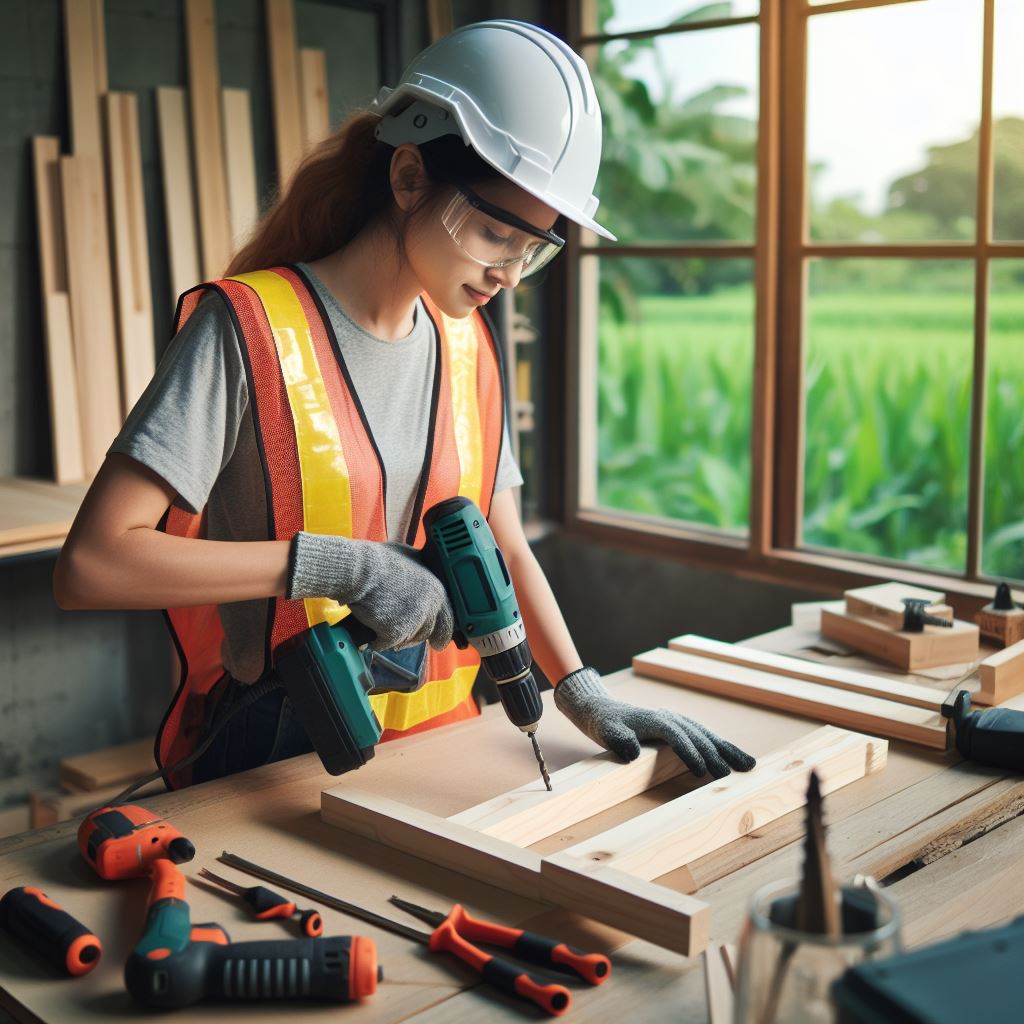Introduction
Building codes are crucial for carpenters in New Zealand as they ensure safety, efficiency, and quality in construction projects.
This blog post aims to highlight the significance of these codes and provide information on their purpose.
Importance of building codes for carpenters in New Zealand
Building codes play a vital role in ensuring the safety of occupants and preventing structural failures in constructions.
Compliance with these codes reduces the risk of accidents and ensures that buildings meet certain standards.
Carpenters rely on building codes to guide their work, ensuring they follow specific requirements regarding materials, structural design, fire safety, insulation, and more.
These codes serve as a benchmark for carpenters to deliver high-quality workmanship.
Moreover, building codes help in regulating the construction industry by maintaining consistency, professionalism, and accountability.
By adhering to these codes, carpenters contribute to the overall improvement of the industry’s reputation and customer satisfaction.
Purpose of the blog post
The purpose of this blog post is to create awareness among carpenters about the importance of building codes in New Zealand.
It aims to emphasize that compliance with these codes is crucial for their professional growth and the safety of the community they serve.
This blog post will also highlight some key aspects of the building codes that carpenters should be familiar with, enabling them to meet the required standards effectively.
By providing relevant information, this post seeks to assist carpenters in their pursuit of excellence and encourage them to prioritize safety and quality in their work.
Overview of Building Codes in New Zealand
Definition of building codes
Building codes are a set of regulations that outline the minimum standards and requirements for constructing buildings.
Role of building codes in ensuring safe and efficient construction
Building codes play a crucial role in ensuring the safety and efficiency of construction projects by providing guidelines for design, materials, and construction methods.
Government agencies responsible for developing and enforcing building codes
In New Zealand, the responsibility for developing and enforcing building codes lies with various government agencies, including the Ministry of Business, Innovation, and Employment (MBIE) and the Building Performance branch.
Overview of building code compliance process
The building code compliance process involves several steps, starting from the design phase to the final inspection and certification. Here is a brief overview of the process:
- Design Phase: Architects, engineers, and designers create plans that conform to the building code regulations.
- Building Consent: Before construction begins, developers must obtain building consent from the local council, ensuring compliance with the code.
- Construction Phase: Builders and carpenters execute the construction according to the approved plans and building code requirements.
- Inspections: Building inspectors conduct regular site visits to check if the construction aligns with the code and approved consent.
- Completion and Certification: Once the construction is completed, a final inspection takes place, and if deemed compliant, a Code Compliance Certificate (CCC) is issued.
Building codes in New Zealand cover structural integrity, fire safety, energy efficiency, accessibility, and weather tightness.
They ensure safe environments. Compliance with codes is crucial to avoid consequences. Carpenters ensure structures meet requirements.
They use approved techniques and materials. Carpenters stay updated with code revisions. They understand design principles and installation techniques.
Building codes establish safe construction practices. Government agencies develop and enforce regulations. Carpenters ensure compliance during construction.
Adherence to codes maintains construction quality and safety. New Zealand benefits from high standards.
Specific Building Codes Applicable to Carpenters in New Zealand
Structural Requirements
- Design and construction of foundations must meet specified standards for strength and stability.
- Building framing requirements dictate the materials and methods used to create the structural framework of a building.
- Carpenters must adhere to the structural integrity standards set forth in the building codes to ensure safe and secure structures.
Fire Safety Requirements
- Construction materials and methods must incorporate fire-resistant materials to prevent the spread of fire.
- Smoke alarms and fire detection systems should be installed in accordance with building codes to ensure early detection and warning.
- Exits and escape routes must be properly designed and constructed to provide a safe means of evacuation during a fire emergency.
Weather Tightness Requirements
- Carpenters have a responsibility to ensure proper weatherproofing during the construction process to prevent water penetration.
- Protection against water ingress should be a core consideration when installing windows, doors, and other openings.
- Proper installation of cladding and flashings is crucial to maintaining the weather tightness of a building and preventing moisture damage.
Accessibility Requirements
- When constructing buildings, carpenters must prioritize creating accessible structures that accommodate people with disabilities.
- Designing for ease of movement and use in accordance with accessibility standards is essential for inclusive building design.
Building codes play a vital role in ensuring that structures in New Zealand are safe, durable, and meet the needs of the community.
Carpenters, as key players in the construction industry, must be well-versed with the specific building codes applicable to their trade.
This blog section will discuss the essential building code requirements that carpenters need to be familiar with in New Zealand.
Structural Requirements
Design and construction of foundations
Carpenters must adhere to the specified standards for the design and construction of foundations.
This includes considering the strength and stability of the foundation to ensure the structural integrity of the entire building.
Building framing requirements
In accordance with the building codes, carpenters need to follow specific guidelines for building framing.
This involves selecting appropriate materials and employing proper construction techniques to create a strong and sound structural framework for the building.
Structural integrity standards
Meeting the structural integrity standards set forth in the building codes is crucial for carpenters.
This ensures that the building can withstand external forces, such as wind, earthquakes, and other potential hazards, thereby promoting the safety of its occupants.
Personalized Career Consulting
Unlock your potential with expert career advice tailored to your goals. Get personalized guidance and actionable steps toward your dream career in New Zealand.
Get StartedFire Safety Requirements
Fire-resistant materials and construction methods
Carpenters must incorporate fire-resistant materials and construction methods into their work to prevent the spread of fire within a building.
This includes using fire-rated materials for walls, floors, and other components that contribute to fire safety.
Smoke alarms and fire detection systems
Installing smoke alarms and fire detection systems is a vital component of fire safety.
Carpenters need to follow the prescribed building codes for the proper placement and installation of these devices to ensure early detection and effective warning in the event of a fire.
Exits and escape routes
Creating safe and well-designed exits and escape routes is essential in building construction.
Carpenters must comply with building codes to ensure that there are sufficient and easily accessible exits for occupants to evacuate the building quickly and safely during a fire emergency.
Weather Tightness Requirements
Ensuring proper weatherproofing in construction
Carpenters play a critical role in ensuring that buildings are weatherproofed.
They need to follow the building codes to incorporate appropriate measures during construction, such as proper sealing and insulation, to prevent water infiltration and damage.
Protection against water ingress
Preventing water ingress is vital to maintaining the longevity and durability of a building.
Carpenters need to properly install windows, doors, and other openings, incorporating waterproofing techniques and appropriate flashings to protect against water intrusion.
Proper installation of cladding and flashings
To achieve weather tightness, carpenters must install cladding and flashings correctly.
This involves following the building codes’ guidelines for attachment, weatherproofing membranes, joint sealing, and detailing to effectively manage water runoff and protect the building envelope.
Accessibility Requirements
Creating accessible structures for people with disabilities
Inclusive design is crucial in construction. Carpenters must consider accessibility standards, such as adequate wheelchair access, appropriate handrails.
Accessible facilities, to ensure that buildings are accessible and usable for everyone, including people with disabilities.
Designing for ease of movement and use
Ensuring ease of movement and use is also a vital consideration in carpentry.
Carpenters need to take into account ergonomic aspects, such as appropriate handrail height, door width, and stair dimensions, to facilitate safe and comfortable movement within the building.
Generally, carpenters in New Zealand must abide by specific building codes to construct safe, structurally sound, weather tight, and accessible buildings.
The adherence to these codes is essential for promoting the well-being and safety of the occupants and the overall quality of construction in the country.
Importance of Complying with Building Codes
Building codes are regulations and standards set by a government or regulatory body to ensure that buildings are safe, functional, and meet the required standards.
Carpenters play a crucial role in construction projects, and complying with building codes is of utmost importance. Here are some reasons why it is essential for carpenters to follow these codes:
Ensuring the safety of occupants and the general public
The primary objective of building codes is to ensure the safety of the people who will inhabit the buildings.
By complying with these codes, carpenters contribute to creating secure and stable structures that can withstand natural disasters, such as earthquakes or hurricanes.
Building codes provide guidelines for structural integrity, fire safety, electrical installations, and other crucial aspects that guarantee the well-being of occupants and the general public.
Meeting legal and regulatory obligations
Compliance with building codes is not only important for safety reasons but also to abide by the law.
Carpenters have a legal obligation to follow building codes and regulations enforced by local governments.
Failure to comply can lead to penalties, fines, or even legal action that can significantly impact both the carpenter’s career and the construction company’s reputation.
Protecting the reputation of carpenters and the construction industry
Carpenters, as skilled professionals in the construction industry, strive to maintain their reputation for delivering quality work.
By adhering to building codes, carpenters ensure that their construction projects meet the required standards, enhancing their reputation as reliable and trustworthy professionals.
Complying with building codes also contributes to the overall reputation of the construction industry, as it demonstrates a commitment to upholding high-quality standards and ensuring the safety of the public.
Avoiding costly rework and legal consequences
Failure to comply with building codes can result in costly rework and project delays.
If a construction project does not meet the required standards upon inspection, it may necessitate significant modifications or even demolition, leading to additional expenses and wasted time.
Moreover, non-compliance can lead to legal consequences, such as lawsuits or liability claims.
These legal issues can have severe financial implications, potentially bankrupting the carpenter or their construction company.
Transform Your Career with a Professional CV and Cover Letter
Stand out to employers with an ATS-optimized resume and tailored cover letter designed to match your dream role. Let us craft your job application materials for success!
Get StartedComplying with building codes is, therefore, not only important for safety and legal reasons but also for economic considerations.
By following building codes from the initial planning stages to project completion, carpenters can avoid costly errors, rework, and legal disputes, ultimately saving time and resources.
In general, the significance of complying with building codes for carpenters cannot be overstated.
It ensures the safety of occupants and the general public, helps meet legal and regulatory obligations, protects the reputation of carpenters and the construction industry, and avoids costly rework and legal consequences.
By understanding and adhering to building codes, carpenters contribute to the overall well-being of the community and uphold the standards of their profession.
Read: NZ Carpentry: Skills and Tools Needed

Challenges and Considerations for Carpenters in Obtaining Code Compliance
Understanding and Interpreting Building Codes
One of the key challenges faced by carpenters in obtaining code compliance is the need to fully understand and interpret building codes.
Building codes can be complex and comprehensive, requiring carpenters to have a deep knowledge and understanding of their provisions.
Furthermore, codes are regularly updated and revised, adding another layer of complexity for carpenters to stay up to date with the latest requirements.
Due to these challenges, carpenters must invest time and effort in continuous education and training to ensure they can interpret and apply building codes correctly.
Applying Codes to Diverse Construction Projects
Another challenge carpenters face in obtaining code compliance is the application of codes to diverse construction projects.
Each construction project comes with its unique set of requirements and specifications, necessitating carpenters to adapt their knowledge of building codes accordingly.
For example, different codes may apply to residential, commercial, or industrial projects, and carpenters must be able to identify and apply the relevant codes for each project type.
This diversity in construction projects complicates the task of achieving code compliance, as carpenters must possess a broad understanding of building codes and their application.
Collaborating with Other Tradespeople and Professionals for Compliance
Code compliance often requires carpenters to collaborate with other tradespeople and professionals involved in the construction process.
For instance, when constructing a building, carpenters must coordinate with architects, engineers, electricians, plumbers, and others to ensure compliance with various codes.
Collaboration among these professionals is vital to ensure that the different aspects of the project align with building codes and fulfill their requirements.
Boost Your Career with a Standout LinkedIn Profile
Attract recruiters and expand your network with a fully optimized LinkedIn profile tailored to highlight your strengths and professional goals. Let your profile open doors to new opportunities!
Get OptimizedThis collaboration can present challenges such as communication issues, conflicting interpretations of codes, and the need for compromise to achieve compliance.
Navigating the Building Consent Process
Lastly, obtaining code compliance involves navigating the building consent process, which can be complex and time-consuming for carpenters.
Before commencing construction, carpenters must obtain building consent from the local building authority, which involves submitting detailed plans and specifications.
The building consent process often includes multiple reviews, inspections, and revisions to ensure compliance with the codes.
Carpenters must carefully navigate this process to avoid delays and additional expenses, requiring them to have a clear understanding of the regulatory requirements.
In essence, carpenters face various challenges and considerations when striving to obtain code compliance.
Understanding and interpreting building codes, applying codes to diverse projects, collaborating with other professionals, and navigating the building consent process are all crucial aspects that carpenters must address.
By being knowledgeable, proactive, and engaged in continuous learning, carpenters can overcome these challenges and ensure compliance with building codes in their carpentry projects.
Read: Carpenter Apprenticeships in NZ Explained
Resources and Support for Carpenters in Relation to Building Codes
A carpenter’s job involves working with different structures and materials, making it essential to have a strong understanding of building codes.
To ensure compliance and enhance their skills, carpenters can access various resources and support systems:
Training and Educational Programs
Continuous learning is crucial for carpenters to stay updated on the latest building codes and industry practices. Several training and educational programs provide valuable resources
- Carpentry apprenticeships offer on-the-job training and classroom instruction to develop skills and knowledge.
- Vocational training institutes provide courses specifically tailored to carpentry, incorporating building codes into the curriculum.
- Online platforms offer carpentry courses, often accompanied by detailed information on relevant building codes and regulations.
Government Resources and Guidelines
The government plays a vital role in establishing and enforcing building codes. Carpenters can utilize the following resources
- Building code websites provide access to official documents, guidelines, and updates on code amendments.
- Local government offices offer informational brochures, manuals, and guides regarding specific building codes applicable in their jurisdictions.
- Government agencies conduct workshops and seminars to educate carpenters about changes in building codes and best practices.
Industry Associations and Professional Networks
Being part of industry associations and professional networks can offer valuable support to carpenters regarding building codes
- Associations such as the New Zealand Certified Builders Association provide resources, training programs, and networking opportunities specifically tailored for carpenters.
- Online forums and communities allow carpenters to connect with peers, share experiences, and seek guidance on building codes and related challenges.
- Professional networks often organize events featuring guest speakers who specialize in building codes, facilitating knowledge sharing and learning.
Collaboration with Building Inspectors and Engineers
Collaborating with building inspectors and engineers can greatly benefit carpenters in ensuring compliance with building codes
- Regular communication and consultations with building inspectors allow carpenters to clarify code requirements and seek guidance.
- Coordinating with engineers during the planning and construction phases helps in understanding structural aspects aligned with building codes.
- Seeking input from building inspectors and engineers throughout the project minimizes the chances of code violations and ensures high-quality workmanship.
By actively accessing these resources and engaging in ongoing learning and collaboration, carpenters can excel in their craft while adhering to the latest building codes.
Constant growth and compliance will not only benefit their careers but also contribute to safer and more durable structures within New Zealand.
Read: Kiwi Carpenter Salary Insights 2024
Conclusion
Importance of building codes for carpenters
In closing, building codes play a crucial role in the work of carpenters, ensuring safety, durability, and functionality in construction projects.
Compliance with these codes is of utmost importance to maintain professional standards and ensure successful outcomes.
Encouragement for carpenters to prioritize code compliance for successful construction projects
Carpenters should prioritize code compliance and view it as an integral part of their craft.
Adhering to building codes not only safeguards the lives and well-being of occupants but also protects the reputation and credibility of the carpenter, leading to more opportunities and a thriving business.
Final thoughts and call to action for continuous learning and improvement in building code compliance.
Continuous learning and improvement in building code compliance is a necessary step for carpenters to stay up to date with the latest regulations and techniques.
By expanding their knowledge and skills, carpenters can ensure they are delivering high-quality work that meets or exceeds code requirements.
Lastly, carpenters must recognize the significance of building codes and make a commitment to adhere to them diligently.
Compliance not only ensures safe and successful construction projects but also reflects a professional and responsible approach to their craft.
By continuously learning and improving in building code compliance, carpenters can elevate their skills and contribute to the overall quality of the construction industry.




